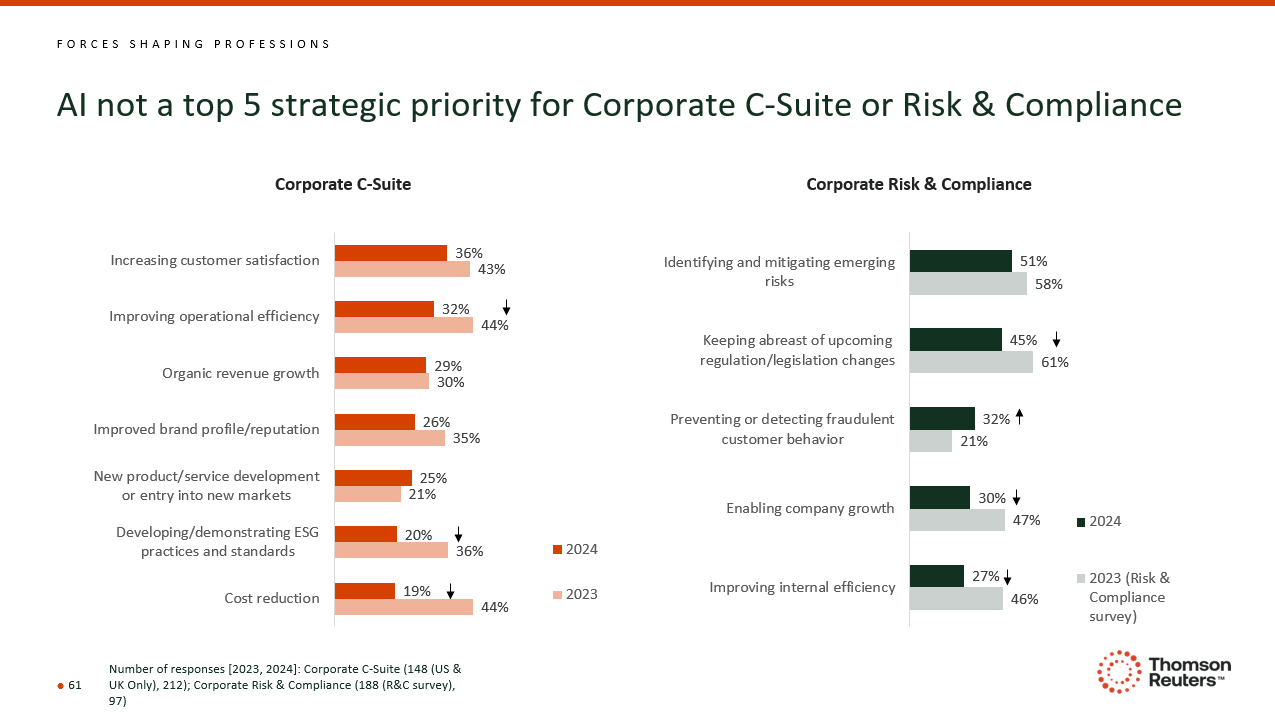The lack of shared strategic priorities between the C-Suite and their risk & compliance professionals can lead to operational inefficiencies, inadequate risk mitigation, and regulatory non-compliance, putting the company at risk of fines and reputational damage
All sections of an organization have to work together for it to properly function and fulfill its risk management and compliance objectives. In understanding this basic framework, it is important to understand two very unique groups: the members of the corporate C-Suite, which includes most senior executives in an organization; and members of the corporate risk management & compliance teams tasked with protecting the interests of the company by making sure that those interests are in line with government and regulatory standards.
The dynamic between corporate C-Suite executives and their risk & compliance professionals is crucial to a company’s internal operations. While it might seem that strategic goals would be consistent throughout the organization, each sector has distinct priorities which are their key focuses or objectives that an organization emphasizes to fulfil its mission and vision. Such priorities steer decisions and drive resource distribution, ensuring the unit’s efforts are directed toward the most pressing needs for long-term success. These objectives generally stem from the organization’s strategic plan and aim to tackle significant challenges and seize opportunities within the operating environment.
Despite both the C-Suite and the compliance sector fulfilling vital functions for the business’s sustainability and expansion, aligning their differing strategic priorities continues to be a major hurdle.
Strategic priorities & their importance
The recently published 2024 Future of Professionals Report from Thomson Reuters included a question for risk & compliance professionals and members of the C-Suite concerning their highest organizational priorities over the next 18 months. Corporate C-Suite respondents said they were primarily focused on what they see as overarching strategic objectives, such as: increasing customer satisfaction, improving operational efficiency, achieving organic revenue growth, and more.
In contrast, corporate risk & compliance professionals concentrate on other objectives, including: identifying and mitigating emerging risks, keeping abreast of upcoming regulation and legislation changes, preventing or detecting fraudulent customer behavior, and more.
The lack of shared strategic priorities between the C-Suite and the company’s risk & compliance professionals can indeed lead to significant challenges. One of the primary issues, for example, is operational inefficiencies. When there is misalignment, it often results in duplicated efforts or gaps in risk management. Indeed, different departments might work on similar projects without coordination, leading to wasted resources, time, and efforts. Conversely, some critical areas might be neglected because they fall between the responsibilities of different teams.

Inadequate risk mitigation is another major concern. If risks are not identified or managed effectively due to a lack of integration into strategic planning, the company becomes vulnerable to unforeseen threats. This can happen when the risk & compliance team is not involved in the early stages of strategic decision-making, which can lead to a reactive rather than proactive approach to risk management.
Regulatory non-compliance is a severe consequence of this misalignment. Without a unified approach, the company might fail to adhere to necessary regulations in a timely manner, resulting in fines and reputational damage. This is particularly critical in industries with stringent regulatory requirements, where non-compliance can have far-reaching implications.
Overcoming these issues is crucial for ensuring that risk management and compliance are integral parts of an organization’s strategic decision-making processes. This involves fostering better communication and collaboration between the C-Suite and corporate risk & compliance professionals. By better aligning the strategic priorities of these two groups, organizations can ensure a more cohesive approach to achieving goals while effectively managing risks and complying with regulations.
The role of AI in strategy and risk management
While artificial intelligence has become a transformative force in many industries, it is noteworthy that neither the C-Suite nor their risk & compliance professionals are particularly concerned with AI at present. This may be due to several factors:
-
-
- Lack of understanding — There may be a knowledge gap regarding the potential applications and benefits of AI in strategic and risk management contexts.
- Perceived irrelevance — AI might not yet be seen as directly applicable to their immediate strategic or operational goals.
- Resource constraints — Implementing AI solutions can be resource-intensive, and both groups may prioritize other initiatives.
-
In conclusion, bridging the gap between a company’s C-Suite and its risk & compliance professionals is essential for creating a seamless and effective organizational strategy. By fostering communication and aligning strategic priorities, companies can mitigate risks more effectively, ensure regulatory compliance, and avoid operational inefficiencies. This collaborative approach not only safeguards the company against potential threats but also optimizes resource allocation and reinforces the organization’s resilience in a rapidly changing business environment.
Further, as the potential of AI becomes more apparent, it is crucial for both groups to recognize and harness its capabilities. Addressing knowledge gaps, demonstrating relevance, and allocating resources towards AI initiatives can significantly enhance strategic planning and turbo-charge risk management efforts. Moreover, embracing AI could lead to innovative solutions that drive competitive advantage and sustainable growth for companies, ultimately ensuring that the organization remains ahead of industry trends and prepared for future challenges.
You can download a full copy of the Thomson Reuters Future of Professionals report here.







